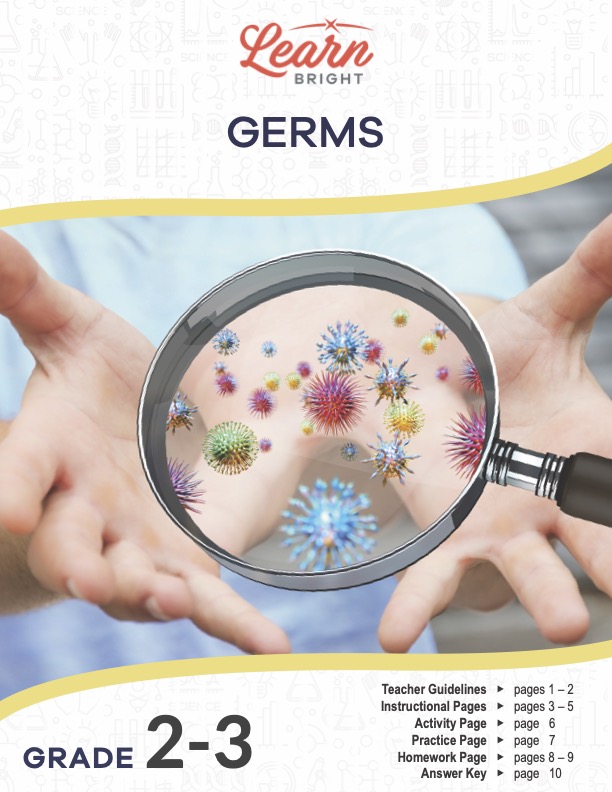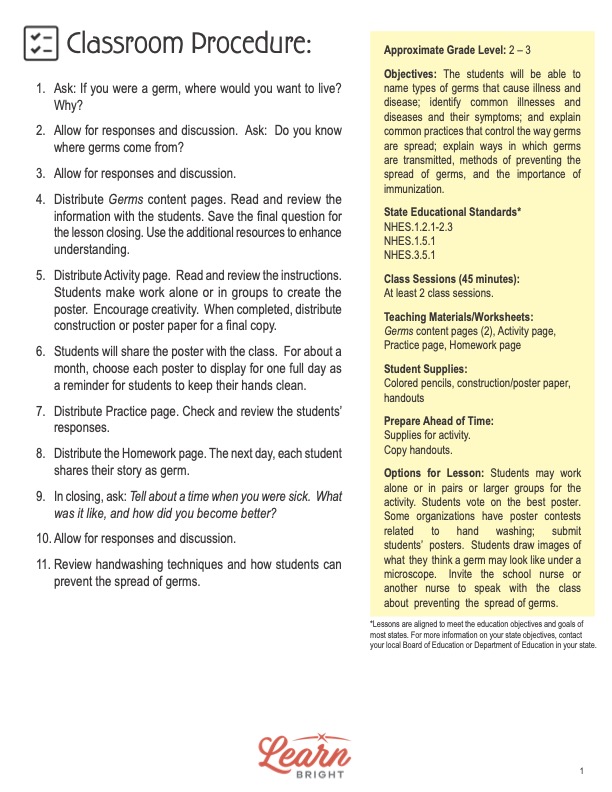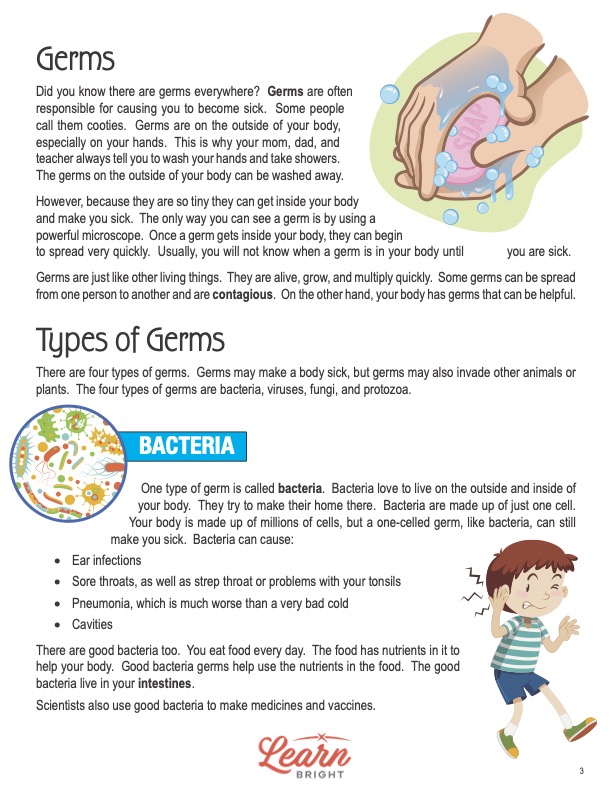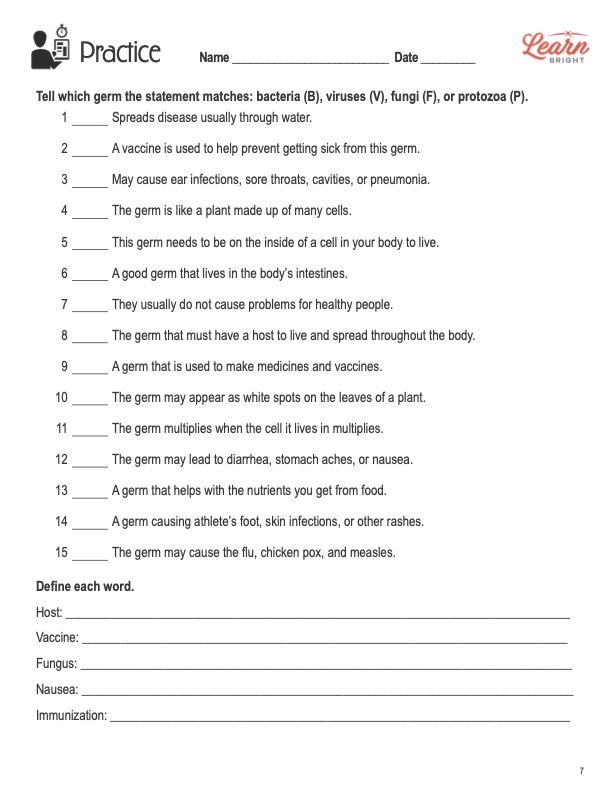Description
What our Germs lesson plan includes
Lesson Objectives and Overview: Germs explores several types of bacteria or viruses that cause illness and disease. Students will learn to identify common sickness and their symptoms and explain ways to control the spread of germs. They will also be able to explain how certain bacteria spread to others and ways to prevent it from happening. By the end of the lesson, they will understand why immunization is important.
Classroom Procedure
Every lesson plan provides you with a classroom procedure page that outlines a step-by-step guide to follow. You do not have to follow the guide exactly. The guide helps you organize the lesson and details when to hand out worksheets. It also lists information in the yellow box that you might find useful. You will find the lesson objectives, state standards, and number of class sessions the lesson should take to complete in this area. In addition, it describes the supplies you will need as well as what and how you need to prepare beforehand. This lesson requires colored pencils and construction or poster paper in addition to the handouts.
Options for Lesson
There are a few suggestions in the “Options for Lesson” section that you might want to take advantage of if you have time or want to extend the lesson. For the Germs lesson plan, one suggestion that relates to the activity specifically is to have students vote on the best poster after everyone completes the activity. You may actually want to pair students up for it or split them into larger groups. Some organizations hold contests related to hand washing. You could submit your students’ posters to those contests as well. Another option is for students to draw images of what they think a germ might look like under a microscope as another activity. You could invite the school nurse or another nurse to speak to the class about preventing the spread of germs.
Teacher Notes
The paragraph on this page explain a little more about the lesson or offers guidance as you prepare. It suggests you include a discussion about immunizations and why they are important. You might also want to watch some videos about bacteria and viruses to supplement the lesson. There are blank lines on the page that you can use to write down any other ideas you have before giving the lesson to students.
GERMS LESSON PLAN CONTENT PAGES
What Are Germs?
The Germs lesson plan contains three content pages. The lesson begins by asking students if they realize that germs are everywhere. Germs are often responsible for making people sick. Cooties, as some people call them, are on the outside of the body, especially on our hands. This is why parents tell their children to wash their hands and take baths or showers. Doing so helps wash away those cooties.
The only way to see a germ is with a powerful microscope because they are very tiny. Despite our best efforts to remain clean, these microorganisms can get inside of our bodies, and when they do, they can make us sick. Once inside us, germs can spread very quickly. Unfortunately, we don’t usually realize we have been infected until we start to feel sick in the first place.
Like all other living things, germs are alive and grow, and they happen to multiply quickly. Some of them are contagious, meaning that they spread from one person to another. On the upside, the body contains germs that can actually help us against cooties.
Bacteria and Viruses
There are four types of germs: bacteria, viruses, fungi, and protozoa. Some types make the body sick, and some invade other animals or plants. The lesson describes a little bit about each type and explains how each one differs from the other three. To start off, students will learn more about bacteria.
Bacteria love to live on both the outside and the inside of our bodies. To many of them, the body is their home. They only have one cell, making them what scientists call single-celled organisms. The human body has millions of cells, but even a one-celled organism like bacteria can make someone sick. They can cause ear infections, sore throats, cavities, and much more. However, not all bacteria are bad. In fact, the body needs good germs too to help use the nutrients in the food it ingests. Good bacteria live in the intestines. In addition, scientists use good bacteria to make medicines and vaccines.
Unlike bacteria, all viruses are bad. These germs are little unique because people start fighting them almost as soon as we’re born. Even as a baby, we get certain shots, called vaccines, that help us prevent getting a particular virus. Viruses have to be inside a cell within the body in order to live. Because the body has so many cells, it is easy for a virus to find a place to live. Once inside a cell, they begin to multiply when the host cell multiplies.
Examples of viruses include chicken pox, the flu (influenza), and the measles. Basically, if a virus finds a host cell that multiples or spreads, the virus can then spread and make someone sick. Vaccines exist for certain viruses, and those include chicken pox, the flu, and measles.
Fungi and Protozoa
The next type of germ students will learn about is fungi. A fungus is like a plant, and instead of having only one cell, it comprises many cells. It can live by feeding off of other plants, people, and animals. These germs like to live in warm and wet places, such as between a person’s toes. Many fungi don’t cause problems for healthy people. Examples include athlete’s foot, skin infections, and other rashes.
Some fungal infections are contagious and can pass from one person to another. And these fungi don’t just cause problems for humans or animals. They can affect plants as well. For instance, if a plant’s leaves show white spots when they otherwise wouldn’t exist, it’s likely the plant has a fungal infection.
The last type of germ is a protozoa. Like fungi, protozoa live in wet places. And like bacteria and viruses, they also have only a single cell. Many live in the water, which is how they spread diseases and infections. Water that is not safe to drink may contain protozoa. These germs can lead to stomach aches, diarrhea, and nausea.
How to Stop Germs
Almost all germs can spread through air when a person sneezes, coughs, or just breathes. They can also spread through sweat, saliva, and blood. People can spread germs by touching things or other people, such as when shaking their hands. One of the best ways to prevent this from happening is the wash our hands with soap and water.
The lesson shows pictures of eight different places for students to wash their hands to ensure they clean them thoroughly. It is completely normal to make contact with other people, which is why it is so important to wash our hands every time we cough, sneeze, and so on. Students will also learn that they should clean their hands before they prepare meals. Additionally, they should wash up after they use the restroom, play outside, touch their pets, and visit someone who is sick.
The lesson advises students to use their elbow to sneeze or cough and avoid getting germs on their hands. They could also use tissues when they sneeze or blow their nose. You can stress that they should never use their sleeves. After all, it is really easy for them to touch their clothes. If they have germs on their clothes, it’s easy to get them on their hands.
Immunizations are also an excellent way to help prevent germs from spreading. These help the body recognize a specific germ and battle against it. Other great ways include eating healthy, exercising, and getting a good night’s sleep. Students will discover that they can’t stop every germ, and nearly everyone gets sick one or more times throughout their lives. But they can at least do their best to stay healthy most of the time.
Key Terms
Here is a list of the vocabulary words students will learn in this lesson plan:
- Contagious: a term to describe something that spreads from one thing to another
- Vaccine: a shot doctors use to help prevent someone from getting a specific virus
- Host: the place (cell) in which a virus lives
- Fungus: a single type of fungi
- Nausea: the discomfort someone feels when they need to throw up
- Immunization: a shot doctors use to help someone fight against specific germs
GERMS LESSON PLAN WORKSHEETS
The Germs lesson plan includes three worksheets: an activity worksheet, a practice worksheet, and a homework assignment. Each one will help solidify students’ grasp of the lesson material. Refer to the guidelines on the classroom procedure page to determine when to hand out each worksheet to the class.
CREATE A POSTER ACTIVITY WORKSHEET
Students will create a poster that encourages people to wash their hands. The worksheet provides a rectangle they can use to draw a picture and write about why washing hands is important. Students will need to be creative. You may want to provide students with poster boards or construction paper and have them use the box on the worksheet as a rough draft.
GERMS PRACTICE WORKSHEET
The practice worksheet has two sections. The first section requires students to read 15 statements. Students must decide if the statement is about bacteria (B), viruses (V), fungi (F), or protozoa (P). For the second section, they will define five words: host, vaccine, fungus, nausea, and immunization.
SHORT STORY HOMEWORK ASSIGNMENT
For the homework assignment, students will write a short story about their life as if they were a germ. They will include a few drawings as well as a title. They can be any type of germ. The story should include information about how the germ spreads from one person to another.
Worksheet Answer Keys
The last page of the PDF is an answer key for the practice worksheet. The correct answers are in red to make it easy to compare to students’ responses. There may be some variation in students’ answer on the definitions section. If you choose to administer the lesson pages to your students via PDF, you will need to save a new file that omits this page. Otherwise, you can simply print out the applicable pages and keep it as reference for yourself when grading assignments.










